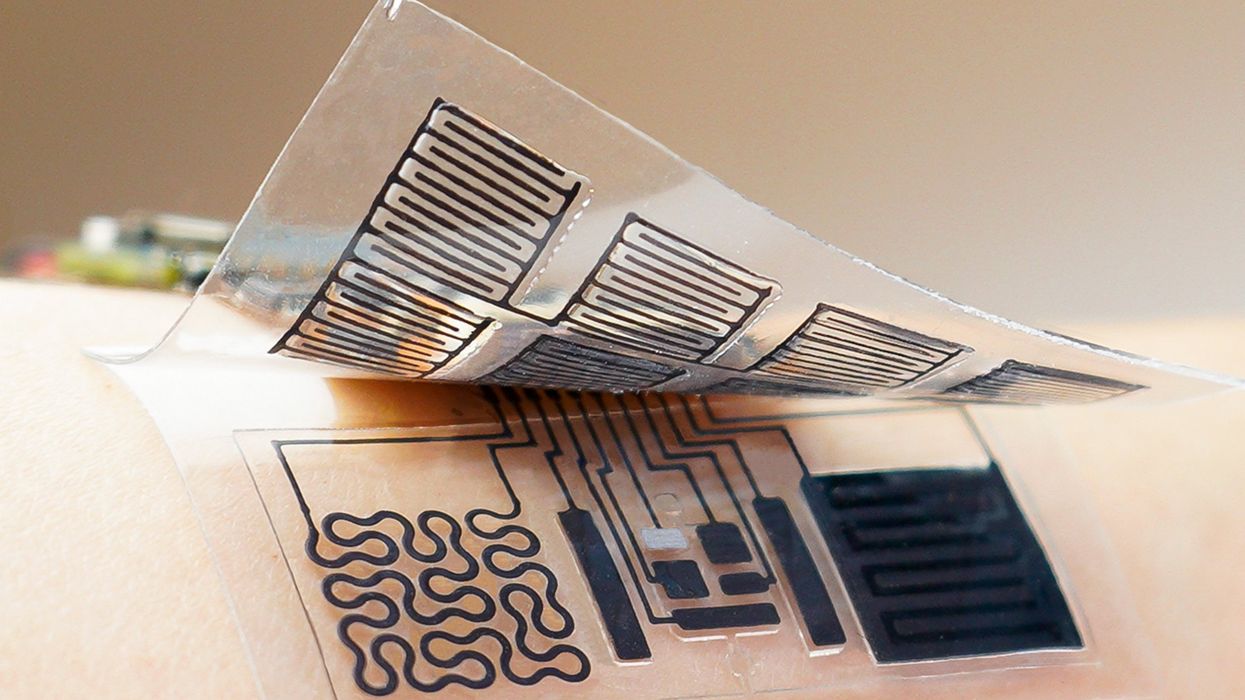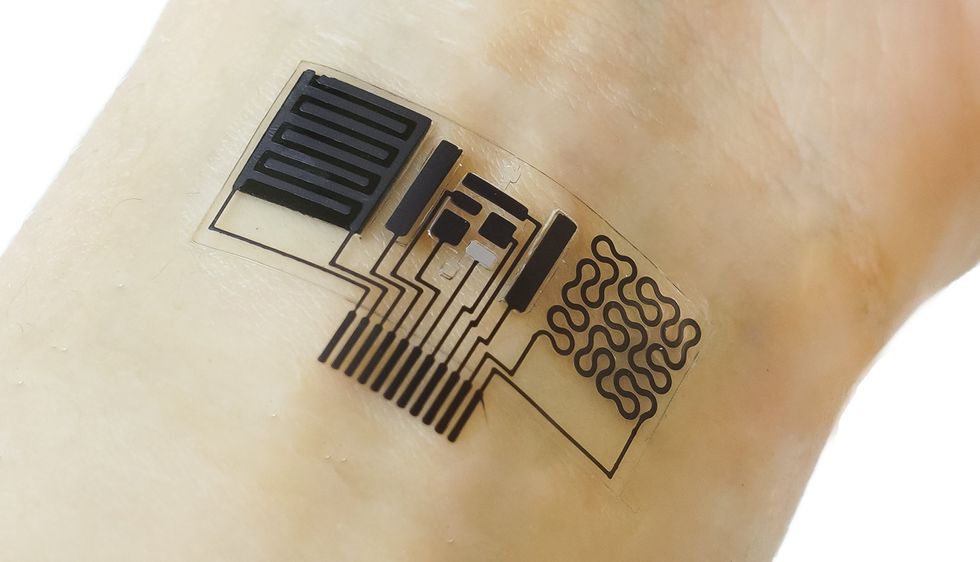Energy Harvesting for Wearable Technology Steps Up

Wearable devices, like nearly every other piece of tech, need energy. Fortunately, though, at wearables' modest power budgets, energy is effectively everywhere. It's in the sun's rays and radio waves, the skin's sweat and body heat, a person's motion and their footfalls. And today, technology is maturing to the point that meaningful amounts of these energy giveaways can be harvested to liberate wearables from ever needing a battery. Which seems plenty attractive to a range of companies and researchers.
Energy is something we take for granted, because we just plug things into the wall, and it feels as inevitable as air. But we do actually need that energy to be generated," says Alper Bozkurt, who with Veena Misra codirects the Center for Advanced Self-Powered Systems of Integrated Sensors and Technologies (ASSIST) at North Carolina State University.
The best-known wearable energy-harvesting tech today is, of course, solar, which pulls down electrons from sunlight or ambient light. But solar is just the opening gambit. There are, researchers have discovered, a wide range of options to harvest enough microwatts to replace wearables' batteries. Among them are piezoelectric and triboelectric generators, which leverage mechanical strain and materials' electrostatic properties to generate electricity. Meanwhile, the well-known phenomenon of electromagnetic induction harvests bumps, jumps, and strides to create tiny but still useful trickles of current.
While wearable devices don't generally require much power, wearables must be, well, easy to wear. A backpack with a giant solar panel might work technically, but not in reality. A light human health sensor would be no use to biologists trying to keep a tracker on a bison for the rest of its life.
The variety of needs-and energy sources-is apparent in a flurry of recent energy-harvesting research, including some hybrid work that integrates multiple modalities.
The power of breaking a sweat Caltech's team has experimented with different forms of energy to harvest for powering its e-skin, including human sweat and friction of materials during movement.Wei Gao/Caltech
Caltech's team has experimented with different forms of energy to harvest for powering its e-skin, including human sweat and friction of materials during movement.Wei Gao/Caltech
California Institute of Technology's Wei Gao developed a self-powering electronic skin." E-skin, he says, is a sensor-embedded device applied directly to skin to read and transmit health indicators like heart rate, body temperature, blood sugar, and metabolic byproducts.
Personalized health care could revolutionize traditional medical practice," Gao says. But to incorporate many different types of sensors, we need different material designs and tools. Not least of those considerations is energy storage [and generation]."
Gao's first e-skin, produced in April 2020, was made of soft, flexible rubber, and it harnessed the patient's sweat to power the device. Using built-in fuel cells, the device absorbed the lactate in the sweat and combined it with atmospheric oxygen to generate water and pyruvate. Through this process the biofuels generated enough electricity to power both the e-skin's sensors and data transmission, continuously charging a capacitor from 1.5 to 3.8 volts for about 60 hours. (For capacitors, voltage translates to electrons stored-the voltage drop across a capacitor is proportional to its total charge.)
Months later Gao and his team developed an e-skin model that used kinetic energy from movement to generate triboelectricity, the liberation of current from the relative motion of materials of differing electrostatic properties. This second-generation e-skin sandwiched thin sheets of Teflon, copper, and polyimide that slide as the person moves, generating maximum power of 0.94 milliwatts.
The team next turned to 3D printing. In a study reported in Science Advances in September, they 3D-printed the essential components-physical sensors, chemical sensors, microfluidics, and supercapacitors-for a multimodal health-tracking system called e3-skin (epifluidic elastic electronic skin).
The platform uses an array of sensors, hydrogel-coated electrodes, and more, along with a microsize supercapacitor that in this case was powered by a solar cell. The precision of 3D printing allows researchers to create customized components for early warning and diagnosis of health conditions, Gao says.
Leveraging watch tech for...bisons?Much talk of wearable technology focuses on health or other human needs. But biologists are also looking at energy harvesting for the tracking of animals, as current technology is insufficient. Batteries die before animals do. Solar won't work for nocturnal animals or creatures in low-light environments. A little device that harvests energy from a runner's evening jog clearly is not designed for a massive bison, which can weigh up to a tonne.
 A team of biologists built a custom Kinefox GPS tracker that wildlife-including this European bison test subject-can recharge simply by moving around as usual.Rasmus W. Havmoller
A team of biologists built a custom Kinefox GPS tracker that wildlife-including this European bison test subject-can recharge simply by moving around as usual.Rasmus W. Havmoller
Those challenges inspired teams of researchers at the University of Copenhagen, the Technical University of Denmark, and Germany's Max Planck Institute of Animal Behavior to build a better wearable-size generator for their purposes: tracking wild animals for, ideally, their whole lives. That goal is currently out of reach-using battery- and solar-powered devices-for most mammalian species.
In work published in PLoS One in May, they detailed the Kinefox, a GPS tracker that wildlife can recharge simply by moving. The team tested their devices with three species: four domestic dogs, an Exmoor pony, and a European bison.
The team was inspired by self-winding watches, which have existed since the late 18th century and transform wrist movement into energy. So the researchers bought a commercial microgenerator designed for wearable and IoT devices called the Kinetron MSG32. They combined it with a lithium-ion capacitor and a custom GPS-enabled tracker that transmits data via the Sigfox low-power wireless network.
We wanted to take the stuff already created and use it off the shelf for animal tracking, even though it isn't designed for that," says Troels Gregersen, guest scientist at the Max Planck Institute of Animal Behavior.
The researchers' first version fitted the Kinefox to the animals' existing collars and harnesses to observe and learn.
However, Gregersen says, the first collar we put on the bison got destroyed immediately. They're 900-kilo animals that run up against trees. It's not a use case in human wearables."
Taking results from the first version, the team ultimately created a custom tracker and collar. They glued the microgenerator's pendulum-based automatic-watch movement to a ferromagnetic ring, placing the combination around a coil of copper wire. As the pendulum swings back and forth with the animal's movement, the ring creates an alternating current in the coil-and a voltage-doubling circuit transforms it into direct current.
There's a lot of value in being able to place a tracker once, when the animal is born, or only having to tranquilize it once," Gregersen says. If something can transmit new types of data, or it can last longer than anything else, it has an application and it has value."
Kinefox is open source, with files published on GitHub. And where a traditional wildlife tracker costs 3,500 to 4,000, the Kinefox costs about 270 in materials, according to researchers at Max Planck.
In the future, DIY may not even be necessary. The team is in talks with the Tilburg, Netherlands-based company Kinetron to make a microgenerator designed specifically for animals, rather than self-winding wristwatches, Gregersen says.
Challenges: Sustainability and industry collaboration This efficient energy harvester combines piezoelectric composites with carbon fiber-reinforced polymer and epoxy resin, a unique combination that was able to store electricity even after 100,000 uses.Tohoku University
This efficient energy harvester combines piezoelectric composites with carbon fiber-reinforced polymer and epoxy resin, a unique combination that was able to store electricity even after 100,000 uses.Tohoku University
Looking to the future more broadly, some researchers are focused on combining unique materials and creating energy-harvesting systems from more sustainable materials. A team including researchers from Japan's Tohoku University recently developed a durable, efficient energy harvester that combines piezoelectric composites with carbon-fiber-reinforced polymer (CFRP).
The group fabricated their device using CFRP, sodium potassium niobate (KNN) nanoparticles, and epoxy resin. And even after 100,000 uses, says Yaonan Yu, a graduate student at Tohoku and co-author of the study, the device could still store the electricity it generated.
This combination of strength and energy generation could be used in several types of wearables and Internet of Things applications, including infrastructure systems to reinforce bridges and highways that sense when a crack, pothole, or other damage appears, Yu says.
The sweet spot, says Bozkurt of the ASSIST center, will be in data analysis-and matching the energy-harvesting capabilities to collect and transmit the data that users truly need.
If I measure your heartbeat in picoseconds, that would be a waste because your heart doesn't beat that quickly," he says. For one project, we asked medical doctors, How much data do you need?' They said, We don't know. We see our patients every month, so if we get more than one monthly reading it'll be an improvement.' That was some perspective."